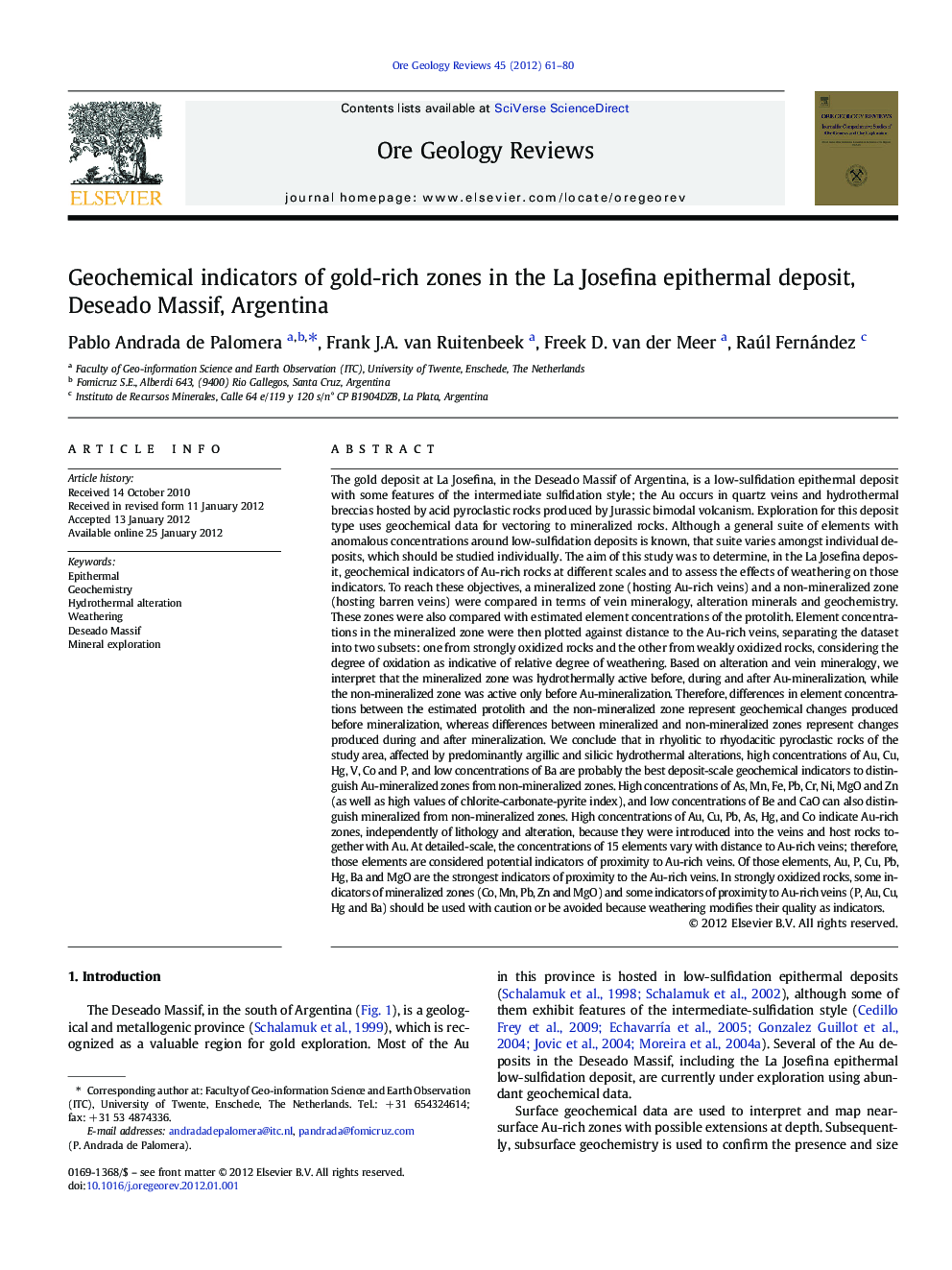| کد مقاله | کد نشریه | سال انتشار | مقاله انگلیسی | نسخه تمام متن |
|---|---|---|---|---|
| 4697712 | 1637258 | 2012 | 20 صفحه PDF | دانلود رایگان |

The gold deposit at La Josefina, in the Deseado Massif of Argentina, is a low-sulfidation epithermal deposit with some features of the intermediate sulfidation style; the Au occurs in quartz veins and hydrothermal breccias hosted by acid pyroclastic rocks produced by Jurassic bimodal volcanism. Exploration for this deposit type uses geochemical data for vectoring to mineralized rocks. Although a general suite of elements with anomalous concentrations around low-sulfidation deposits is known, that suite varies amongst individual deposits, which should be studied individually. The aim of this study was to determine, in the La Josefina deposit, geochemical indicators of Au-rich rocks at different scales and to assess the effects of weathering on those indicators. To reach these objectives, a mineralized zone (hosting Au-rich veins) and a non-mineralized zone (hosting barren veins) were compared in terms of vein mineralogy, alteration minerals and geochemistry. These zones were also compared with estimated element concentrations of the protolith. Element concentrations in the mineralized zone were then plotted against distance to the Au-rich veins, separating the dataset into two subsets: one from strongly oxidized rocks and the other from weakly oxidized rocks, considering the degree of oxidation as indicative of relative degree of weathering. Based on alteration and vein mineralogy, we interpret that the mineralized zone was hydrothermally active before, during and after Au-mineralization, while the non-mineralized zone was active only before Au-mineralization. Therefore, differences in element concentrations between the estimated protolith and the non-mineralized zone represent geochemical changes produced before mineralization, whereas differences between mineralized and non-mineralized zones represent changes produced during and after mineralization. We conclude that in rhyolitic to rhyodacitic pyroclastic rocks of the study area, affected by predominantly argillic and silicic hydrothermal alterations, high concentrations of Au, Cu, Hg, V, Co and P, and low concentrations of Ba are probably the best deposit-scale geochemical indicators to distinguish Au-mineralized zones from non-mineralized zones. High concentrations of As, Mn, Fe, Pb, Cr, Ni, MgO and Zn (as well as high values of chlorite-carbonate-pyrite index), and low concentrations of Be and CaO can also distinguish mineralized from non-mineralized zones. High concentrations of Au, Cu, Pb, As, Hg, and Co indicate Au-rich zones, independently of lithology and alteration, because they were introduced into the veins and host rocks together with Au. At detailed-scale, the concentrations of 15 elements vary with distance to Au-rich veins; therefore, those elements are considered potential indicators of proximity to Au-rich veins. Of those elements, Au, P, Cu, Pb, Hg, Ba and MgO are the strongest indicators of proximity to the Au-rich veins. In strongly oxidized rocks, some indicators of mineralized zones (Co, Mn, Pb, Zn and MgO) and some indicators of proximity to Au-rich veins (P, Au, Cu, Hg and Ba) should be used with caution or be avoided because weathering modifies their quality as indicators.
► Zones hosting Au-rich and barren veins are distinguishable by geochemistry.
► Concentrations of 15 elements are functions of distance to Au-rich veins.
► The best indicators of distance to Au-rich rocks are P, Au, Cu, Pb, Hg, Ba and MgO.
► Weathering decreases the usefulness of some geochemical indicators.
Journal: Ore Geology Reviews - Volume 45, June 2012, Pages 61–80